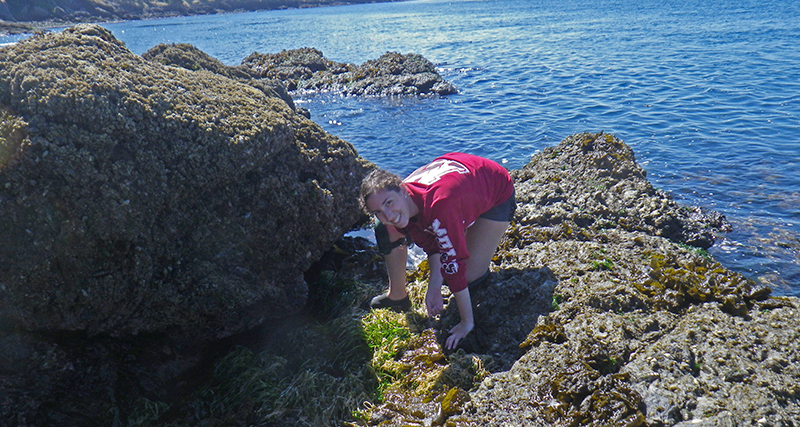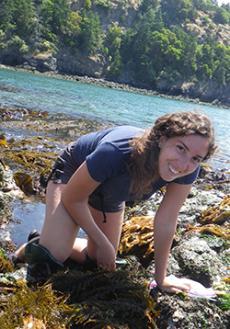Summer Research Can Take You Places—Like This Beautiful Island in the Pacific Northwest
Brooke Torjman '19 learned lifelong scientific skills while examining the shell preferences of hermit crabs off the coast of Washington.By: Meghan Kita Wednesday, September 27, 2017 09:10 AM
 Brooke Torjman '19 searches for hermit crabs as part of the summer research she conducted on Washington state's San Juan Island. Photos courtesy of Brooke Torjman.
Brooke Torjman '19 searches for hermit crabs as part of the summer research she conducted on Washington state's San Juan Island. Photos courtesy of Brooke Torjman.When you think of hermit crabs, you may picture the ones sold as pets in boardwalk shops at the shore. They’re displayed in tanks that appear to hold only an expanse of shells until maybe, after a few minutes of watching, you notice knobbly crustacean legs emerging from one of them. They may be the world’s most boring pets—but in the wild, their lives are anything but.
Just ask Brooke Torjman ’19, who spent the summer researching hermit crabs on Washington state’s San Juan Island with her mentor, biology professor Erika Iyengar. “If you look at any regular crab, they have a hardened carapace,” Brooke says. “Hermit crabs don’t have that—the abdomen is squishy and soft. Without a shell, they’re going to get eaten or they’ll dry out and die.”
And, because they don’t produce their own shells, they rely on abandoned ones to survive. “Hermit crabs molt to grow, so they routinely need bigger shells,” she adds. “They’re constantly fighting over them.”
Brooke researched how hermit crabs choose their shells. In the wild, she found that shells from the most prevalent snail species in a given area were most popular among the hermit crabs in that area. When given the choice between four types of shells in a lab environment, however, the crabs didn’t necessarily choose the ones they would in the wild—which indicates that, in times of fierce competition, they simply choose whichever available, appropriately sized shell they can wrest from a weaker crab.
 “I kind of just geeked out over how cool I thought everything was,” Brooke says.
“I kind of just geeked out over how cool I thought everything was,” Brooke says.
Iyengar got to witness Brooke maturing as a researcher, in the field and in the lab. “The difference in her approach to science from the beginning of the summer to the end of the summer is amazing,” Iyengar says. “At one point, she said, ‘It’s just so much more complex than I thought—there are so many variables to consider, so many things to control for.’ That is a good and healthy attitude.” The immersive experience of doing research full-time accelerates the growth students might only begin to experience doing a few hours of lab work per week during a semester, she says.
It helped that Brooke was working with Iyengar, who’s been conducting research on San Juan Island for 20 years. “I was her only research student,” Brooke says. “It was great having that one-on-one time and having her teach me the skills of being a researcher. She really trained me to think the way a scientist does out in the field.”
Brooke says the experience made her reevaluate her path. “For the first year and a half of college I was premed. For my whole life, it was being pushed upon me. Now, I’d like to move on to grad school and pursue a Ph.D. in marine ecology,” she says. “I really like the outdoors and nature and being surrounded by living things. I found my niche.”
